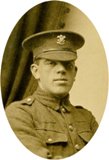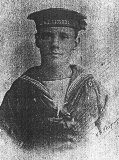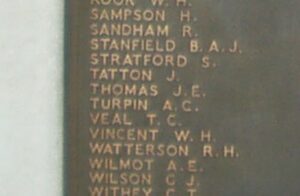Llandyfriog is a Parish in the hundred of Troedyraur, which lies just 1 1/2 miles east of Newcastle Emlyn, inside the southern border of Ceredigion. The parish takes its name from its parish Church, which is dedicated to St. Tyfriog, a saint who lived during the sixth century, and is situated on the northern bank of the river Teifi, on the road from Newcastle Emlyn to Lampeter. Situated within the Church are several memorials; The WW1 and WW2 Memorial, Llandyfriog Parish WW1, Major JKL Fitwilliams, MC, L/Cpl WLL Fitzwilliams, and one which commemorates the 12th Divisional Train, Army Service Corps. This memorial is on a separate page.

The Great War, 1914-1918
David George Davies, Stoker 1st Class, K/27472, Royal Navy. David was born at Llandyfriog on 15 January 1897, the son of Evan and Margaret Davies. His parents moved to 112, Priory Street, Carmarthen, but David resided at 10, Railway Terrace, Henllan prior to the war. He enlisted into the Royal Navy, and was posted to HMS Vivid, the Royal Naval establishment at Portsmouth. David died of sickness at Stonehouse, Devon on 2 May 1917. He was 21 years old, and is buried at Llandyfriog (St. Tyfriog) Churchyard. David is not commemorated on the Llandyfriog Memorial, but at nearby Aberbanc.

David Thomas Davies, Sapper, 277031, Royal Engineers. David was the son of Thomas and Mary Davies, of Garregwen, Llandyfriog. He had served with the Royal Engineers, before becoming attached to the 564th Company, Labour Corps. David survived the war, but died at home on 22 November 1918, aged 33. He is buried at St. Tyfriog Churchyard, at Llandyfriog.

John Kenrick Lloyd Fitzwilliams, MC, Major, Royal Field Artillery. John was the son of Charles Home Lloyd Fitzwilliams and Margaret Alicia Fitzwilliams (nee Crawford), of Cilgwyn, Newcastle Emlyn, and the Husband of Margery Laura Fitzwilliams (nee Hyde), of Longworth House, Faringdon, Berks. John had been originally commissioned into the Royal Horse Artillery prior to the war, and was serving with G Battery, RHA at the outbreak of war, landing in France on 6 November 1914. By the start of the Battle of the Somme on 1 July 1916, John had been promoted Captain, and served with the 25th Army Brigade, Royal Field Artillery. John was awarded the Military Cross for conspicuous gallantry during the Somme Battles, and was promoted to Major at the same time. His Battery served with the 1st Division and was taking part in the Advance on the Hindenburg Line when John was killed in action on 30 August 1918. He was 33 years old, and is buried at Vis-En-Artois British Cemetery, Haucourt, France. John was also the holder of the Order of St Stanislaus, 2nd Class (Russia).


John George Griffiths, Driver, 80296, Royal Field Artillery. John was the son of Richard and Anne Griffiths, of Derwanlas, Llandyfriog. He enlisted at Mountain Ash into the Royal Field Artillery, and served with their ‘A’ Battery, 76th Brigade, attached to the Guards Division. The Division has the distinction of being formed in France in August 1915. The various Guards units that had been with other Divisions were withdrawn to be brought together to create this fine formation. It remained on the Western Front throughout the war and saw its first major action during the Battle of Loos on 25 September, 1915, remaining in the area during the coming months, where they also fought in the subsequent Action of Hohenzollern Redoubt. In July, 1916 the Division moved to the Somme, where they fought at the Battle of Flers-Courcelette, and then at the Battle of Morval, capturing Lesboeufs Village. They remained here for the winter, which is where John took ill. He died of bronchitis on 6 March 1917, aged just 19, and is buried at Grove Town Cemetery, Méaulte.


Samuel Thomas Havard, Corporal, 1268, Welsh Guards. Samuel was born in 1898, the son of Benjamin and Anne Havard, of Woodlands, Henllan. He resided at Neaudd, Trebedw, prior to the war, and served with the 1st Battalion, Welsh Guards. The Welsh Guards were raised by Royal Warrant of 26 February 1915, at White City. On 28 April 1915 the battalion moved to Sandown Park, then on to Wellington Barracks, before landing in France on 18 August 1915. Here the Welsh Guards became attached to the 3rd Guards Brigade, Guards Division. They fought at Loos in September 1915, and the following year at Ypres and on the Somme. During 1917 the Guards fought at Third Ypres, and Cambrai, and later in 1918 took part in the great advance, ending their war at Maubeuge. Samuel survived the war, and returned home, but died on 23 May 1920, as a result of his service. He was 22 years old, and is buried at Llandyfriog (St. Tyfriog) Churchyard. His brother, Jim, had also suffered during the war, being invalided home in 1918 suffering from trench fever, after serving with the Northumberland Fusiliers.


James Arthur Jones, Private, 59656, Royal Welsh Fusiliers. James was the son of Mr. and Mrs. Ben Jones, of Plas Hill Llandyfriog. He worked as a Salesman in London prior to the war, and enlisted at Marylebone into the 13th Battalion, Royal Welsh Fusiliers, who were attached to 113 Brigade, 38th (Welsh) Division. The Division had landed in France during December 1915 and had spent their first winter in the trenches near Armentieres, before taking part in the capture of Mametz Wood in July 1916. James probably joined the battalion after it had been withdrawn from Mametz, via Hebuterne to Ypres. Here they fought at Pilckem and Langemarck, then moved to Armentieres, where they remained from September 1917 until March 1918 when the German Spring Offensive was launched. The British had been over-run on the Somme, and so in April the Division was moved south, taking up positions North of Albert, from where they weathered the storm of the coming months, until the war turned during the Battle of Amiens, on 8 August 1918. The Germans had now lost the upper hand, and the British regained the lost ground on the Somme after an attack which began on 21 August, with the 38th Welsh in the midst of the attack during the Battle of Albert, and then moving east, where they fought at the Battle of Bapaume. Then the move began towards the mighty Hindenburg Line, and the Division carried on with their march east, fighting at the Battle of Havrincourt, and the Battle of Épehy. A short rest period ensued, during which time the Canal du Nord was breached, so opening a passage through the Hindenburg Line. The Division then fought at the Battle of Beaurevoir, and moved up towards Cambrai, where James was killed in action on 8 October 1918. He was 30 years old, and is buried at Moulin-De-Pierre British Cemetery, France.


Samuel Richard Jones, Private, 372382, Royal Army Medical Corps. Samuel was the son of Thomas and Judith Jones, of Aberarad, Newcastle Emlyn, and enlisted at Cardiff on 27 October 1915 into the Royal Army Medical Corps. Samuel was then posted to the 3rd Western General Hospital, Neath. He became ill there, and died of tuberculosis on 30 July 1917, aged 32. Samuel is buried at Llandyfriog (St. Tyfriog) Churchyard.

William Enson Jones, Lance Corporal, 20108, Welsh Regiment. William was born at Llandyfriog, and moved to Garnant prior to 1911 to work for the Great Western Railway. He married Hannah Jones (nee Rees), a widowed mother of four young children, in 1910, and the couple resided at Tyddewi, Garnant Road, Garnant. William enlisted at Ammanford into the 15th Battalion, Welsh Regiment, which was known as the Carmarthen Pals battalion. After training at Rhyl and Winchester the battalion moved to France on 2 December 1915 attached to 114 Brigade, 38th (Welsh) Division. William didn’t go out to France with the battalion, but was posted out with a number of reinforcements to the 16th Battalion, Welsh Regiment, which was attached to the same division. He was probably wounded during the battalions gallant attack on Mametz Wood on 7 July 1916, and returned home where he died on 21 July 1916, aged 29. He is buried at Garnant (Old Bethel) Welsh Congregational Chapelyard.

Harold Lloyd-Jones, Second Lieutenant, Royal Welsh Fusiliers. Harold was born at Cardiff in 1898, the son of Harry and Maggie Lloyd-Jones. The family resided at 7, Regency Street, Westminster. Harry was educated at Llandyfriog and at Aberystwyth University before becoming a solicitor in London. He was commissioned into the Royal Welsh Fusiliers in August 1917, but resigned his commission in April 1918 after being diagnosed with heart disease, and died in London on 1 July 1918, aged 19. His body was brought back by train for burial at Llandyfriog (St. Tyfriog) Churchyard.

Titus Lewis, Private, 15661, Welsh Regiment. Titus was the son of Thomas and Mary Lewis, of Brynhyfryd, Adpar, Newcastle Emlyn. He enlisted at Neath into the 9th Battalion, Welsh Regiment, which was attached to 58 Brigade, 19th (Western) Division. The battalion moved to France on 18 July 1915, and moved with the division to positions near Loos, where it took part in the opening attack of the Battle of Loos on 25 September 1915. Titus was killed in action during this attack, on 25 September 1915. He was 25 years old, and is buried at Brown’s Road Military Cemetery, Festubert, France.


John Owen, Driver, T/1863, Royal Army Service Corps. John was born at Cardigan, but resided at Newcastle Emlyn prior to the war. He enlisted at Pentre into the Army Service Corps, and was attached to the Welsh Division Train, part of the 53rd (Welsh) Division. The Division moved to the Mediterranean, sailing from Devonport in July 1915 arriving at Mudros by 5 August 1915. From here they moved to Gallipoli, landing on 9 August. Here they immediately faced the chaotic leadership that was to lead to the ultimate failure of the campaign, and spent the next few days in isolated pockets, fighting against a Turkish counter-attack. The Division remained here throughout the coming months in terrible conditions, and John was taken ill. He was evacuated to the Base Hospital at Alexandria where he sadly died on 23 September 1915. He is buried there at Alexandria (Chatby) Military Cemetery, Egypt.

John Edmund Thomas, Deck Hand, 1253SD, Royal Navy. John was born on 1 January 1895, the son of George and Ann Thomas, of Penddol, Llandyfriog. He served in the Royal Navy aboard H.M. Trawler Euston. She had been hired by the Admiralty during the war, and struck a mine off Hartlepool on 12 February 1917. John was 22 years old, and was killed in the resulting explosion, and is commemorated on the Plymouth Naval Memorial, Devon.


World War Two, 1939-1945
Ridley Athol Bainbridge, Second Engineer Officer, Merchant Navy. Ridley was born in Northumberland in 1909, the son of Winifred Bainbridge, and lived with his wife Caroline Jane Bainbridge, at Keepers Lodge, Newcastle Emlyn. He was a long serving Merchant Mariner, and was serving as Second Engineer aboard the MV Gatinais, a 383 gross tons Southampton registered passenger vessel. On her final voyage, Gatinais set sail from Portsmouth to Llanelly, with a cargo of scrap iron. She was sunk by a German E-Boat torpedo attack whilst five miles from Start Point on 3 December 1942, and sank. Ridley was killed in the attack. Of the twelve men aboard Gatinais, only three survived. Ridley was 33 years old and is remembered on the Tower Hill Memorial, London. His widow moved to Potters Bar, Middlesex.

Thomas Benjamin Morris, Sergeant, 1325871, Royal Air Force Volunteer Reserve. Thomas was the son of Hugh and Mary Ann Morris of Llandyfriog, and the husband of Rachel Bowen Morris, of 32a, Morris Street, Morriston. He served with 149 Squadron, RAFVR, which was a Night Bomber unit equipped with the Vickers Wellington. The squadron played a prominent part in the early offensive against Germany, Italy and enemy-occupied territory and, after having re-equipped with Stirling’s, took part in the first 1,000-bomber raids. In 1943 it made a significant contribution to the Battle of the Ruhr, and also took part in the Battle of Hamburg and the famous raid against the German V-weapons experimental station at Peenemunde. On 29 May 1943 Thomas took off in his Short Stirling, from their base at RAF Lakenheath in Suffolk. The Squadron were forming part of a massive force of 719 aircraft, bound for Wuppertal in the Ruhr Valley. The Stirling was brought down by German Night Fighters on the return journey on the morning of 30 May 1943 and Thomas was killed in the resulting crash. He was 29 years old, and is remembered on the Runnymede Memorial Surrey.
David Dan Haydn Thomas, Third Engineer Officer, Merchant Navy. David was the son of D. J. Thomas, and of Elizabeth J. Thomas, of Adpar, and served in the Merchant Navy, as an Engineer aboard the S.S. Parracombe (London). The Admiralty sent plans to the C-in-C Med, concerning the intended sailing of the SS Parracombe early in April 1941. She was carrying about 12 Hurricanes, a number of Harvey projectors with their ammunition and other stores direct to Malta from Gibraltar, and was disguised as Vichy French, unescorted and manned by picked crew, with orders to be scuttled if captured. The Parracombe was attacked by Italian Torpedo Bombers and sunk on 2 May 1941, and David was killed. He was just 20 years old, and is remembered on the Tower Hill Memorial, London.
